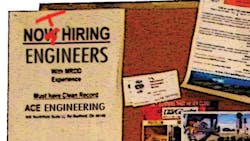October 10, 2013 Letters
One engineer can make a difference
A reader wants to make sure others know who is responsible for the engineering that helps explain and solve water hammer. Another reader points out that engineers have been developing tools and technology that eliminates engineering jobs for a long time.
Claiming credit
Much of the theory presented in a recent article (”Taming Water Hammer,” Feb. 14), I had first published in a series of conference and journal papers starting in 2001. When first published, I fought to get it accepted by the profession as some influential engineers disagreed at the time. Since then, I have presented the theory at numerous ASME Conferences and B31 Committee meetings and taught it to hundreds of engineers and operators. Now, the theory is well accepted by many, published in my recent ASME text, and it provides a technical basis for the new piping standard (ASME B31D, Design of piping systems for dynamic loads from fluid transients), which I am writing as a member of the ASME B31 Mechanical Design Committee.
It appears the article’s author also accepts my work. In other words, a theory I discovered over 10 years ago has become common knowledge. A primary goal of my research was to affect engineering design and analysis to reduce operating costs, improve safety, and prevent deaths at industrial facilities. Publication in Machine Design furthers that aim.
Robert A. Leishear
A full discussion of the development and status of piping response with respect to fluid transients is available in Robert Leishear’s new book, Fluid Mechanics, Water Hammer, Dynamic Stresses, and Piping Design, ASME Press, NY, NY, 2013.
Engineering eliminates engineers
I was quite astonished to read the recent commentary (“Will the 3D Printing Revolution Kill Engineering Jobs?” July 9). The industry has been distributing false information regarding the need for engineers for as long as I can remember. Your break with this tradition is radical and unique, especially coming from a member of the (evil) media.
As you must know, the role of the engineer is to minimize the resources needed for the necessities of life (“an engineer is a person who can do for a dollar what anyone can do for one hundred dollars”). “Resources” include engineers themselves.
One of my first engineering assignments (1966) was to automate the engineering process for designing hydraulic pump turbines. A 65-yr-old engineer who headed a small group of engineers walked me through the design process. The average time to complete this process was about six months. After working with him for two months, I wrote a program that completely automated his design process and could do the job in 15 minutes. The design department then went from about a dozen engineers to just one.
I contributed to eliminate engineering hours by helping companies develop numerically controlled machining machines, then CAM, and finally CAD.
My last assignment was to review the electronic-component-design process at Ford and reengineer it to eliminate half of the engineers needed. Working in a four-person team, we were able to eliminate 75% of the engineers who once were tasked with electronic-component design, and substantially reduce warranty losses.
So you see, your prediction of an ever-decreasing need for engineers does not depend on 3D printing and associated processes and automation. It is an inherent result of engineering itself.
Joe Iaquintio
The only thing I have seen reduce engineering head count is experience. The engineers that I see who have a broad range of experience across industries still have one up on specialists. I see this as unfortunate but consistent. Just because an individual can bypass all the detail of designing something does not mean they are unneeded. It just means that there will be a bunch of clueless people making a bunch of nice-looking unsafe junk.
Robert V. Anthony
